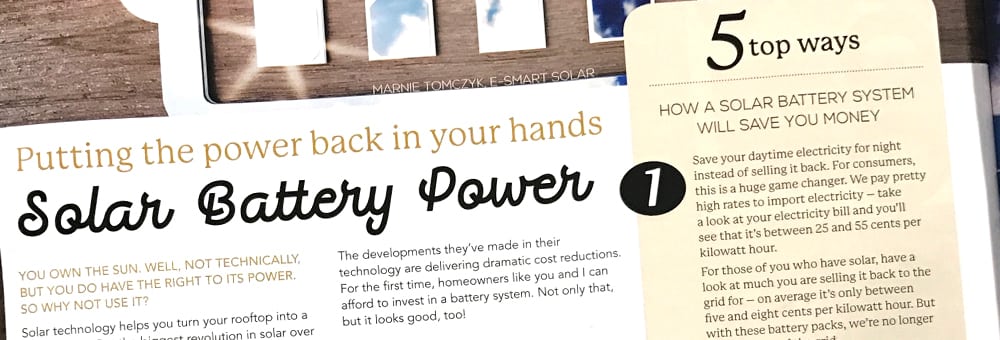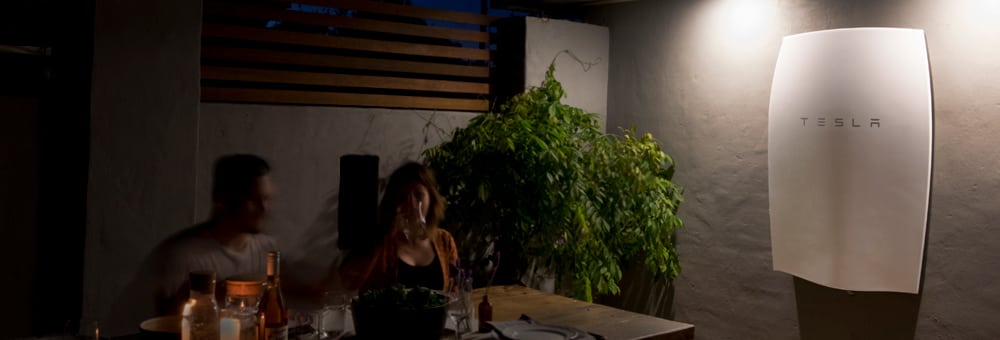You own the sun. Well, not technically, but you do have the right to its power. So why not use it?
Solar technology helps you turn your rooftop into a power plant. But the biggest revolution in solar over the past few years is undoubtedly the arrival of a new breed of battery systems.
It isn’t new technology – in actual fact, solar batteries have been around for decades. They’ve just always been super-expensive (as well as huge and incredibly unattractive!). But that all changed in 2015 when Tesla announced its revolutionary Tesla Powerwall. It was everything that us solar lovers wanted – a relatively low price point and a solid consumer warranty.
But I’m getting ahead of myself. First of all, let me explain a little bit more about solar battery systems.
What is a solar battery system?
Although solar is renewable energy, it has its limitations. One of these is that it can’t produce power during times of little or no light.
A solar battery, however, makes this a non-issue. It stores any excess energy your solar panels make during the day for you to use during the night.
I think about it in these terms. During the week, we’re generally at home of an evening. We come home from work, use the lights, cook dinner, put washing on, use the air conditioner in summer and the heater in winter, kick back in front of the TV… the electricity system gets a beating. And because we’re rarely at home to do this during the day when our solar energy is readily available, our homes are reliant on the power produced by the electricity grid.
But with a battery, your home will use the excess energy your system has stored during the day before it turns to the electricity grid. Take that, rising electricity costs!
Why all the fuss about battery systems?
For us renewable energy fans, the new generation of battery systems is a game changer. For so long they’ve been too expensive for the average household or small business to consider, but Tesla Powerwall has completely changed the landscape.
The developments they’ve made in their technology are delivering dramatic cost reductions. For the first time, homeowners like you and I can afford to invest in a battery system. Not only that, but it looks the goods, too!
Who is Tesla and what is Tesla Powerwall?
I think of Tesla as the ‘Apple’ of solar technology. They’re constantly creating new things, pushing the boundaries and redefining the game for the other players in the market (such as Enphase and LG Chem). And if the name sounds familiar, there’s a reason why. They’re also the creators of electric cars.
They’re undoubtedly the leaders in the renewable energy market, but their innovation has forced the other players to up their game. All of a sudden solar battery storage has become a very real option for families to reduce their electricity costs even further.
What are the benefits of a solar battery system?
I’m a self-confessed devotee of renewable energy, so for me it’s all about the environment. But for a large percentage of our clients, it’s very much about the cost savings.
Our electricity costs are among the highest in the world. Not only that, but they’re increasing. Combine that with the fact that ‘luxuries’ are now often considered ‘essentials’ – take the record-breaking day we had last month where air conditioning was just not negotiable – and it’s just not feasible for either families or small businesses. But a battery system can put some power back into our hands (yes, pun intended).
My top 5 ways a solar battery system will save you money
- Save your daytime electricity for night instead of selling it back. For consumers, this is a huge game changer. We pay pretty high rates to import electricity – take a look at your electricity bill and you’ll see that it’s between 25 and 55 cents per kilowatt hour.
For those of you who have solar, have a look at much you are selling it back to the grid for – on average it’s only between 5 and 8 cents per kilowatt hour. But with these battery packs, we’re no longer at the mercy of the grid. Instead, we can use our solar 24 hours a day, seven days a week.
So instead of selling your surplus power back at a small rate, you’re far better off to use it yourself during peak periods. - Store electricity from the grid when it’s cheap. So if you’re going to use electricity, why not store it when prices are lowest? If you store it from the grid during off-peak but use your battery for power during the most expensive peak time (instead of buying from the grid, that is), you’ll reduce your overall electricity costs.
- Increase your solar consumption. For the average home, a battery system can almost double your solar usage. Adding a 14 kilowatt hour battery (such as Tesla Powerwall) to a 5 kilowatt solar system can increase your amount of self-consumption between a whopping 30 and 60%!
- Future-proof your home or business. It’s predicted that battery storage is going to be the main way families manage their electricity costs by 2019. Battery storage costs are falling, while grid electricity prices are increasing. Future-proofing your home now will also save you in the future.
- Keep your electricity expenses economical even though the feed-in tariff has stopped. The government’s feed-in tariff ceased this year, meaning that individuals with solar who were on the feed-in tariff no longer receive a generous rate for the solar electricity they put into the grid. Electricity prices aren’t going to change, so I truly believe that it’s inevitable that solar systems with battery storage will become the most economical solution to provide electricity.
It’s undoubtable that renewable energy is our future. And as prices continue to fall, battery storage will give you ongoing cost savings by letting you use more of your own solar electricity, while also letting you access and store electricity from the grid when it’s cheapest.
And just to hold myself accountable, I’ve recently installed a Telsa Powerwall on my home and am tracking the changes it makes to our electricity consumption. So keep your eyes peeled and I’ll keep you updated!






